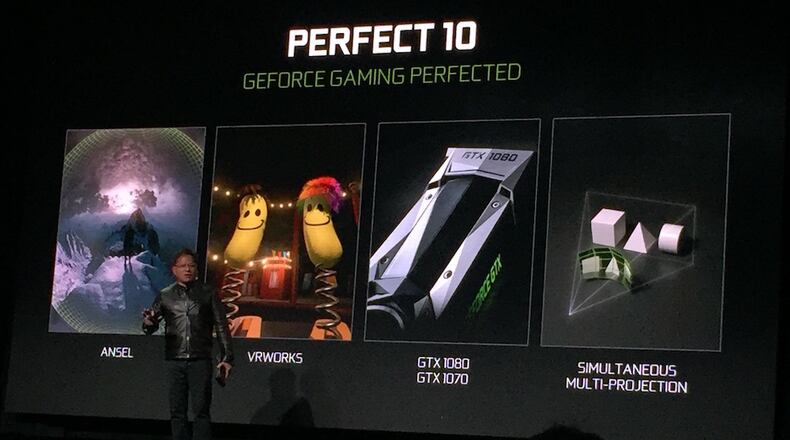Austin was the center of the video game graphics world on Friday night as chip company Nvidia revealed a new PC graphics cards it says are the fastest in the world, topping its own previous generation by at least twice the speed and three times the efficiency of its previous generation.
The Geforce GTX 1080, which debuts at a price of $599 and the GTX 1070, priced at $379, use the company's new "Pascal" architecture. For video gamers, it means faster, smoother performance for games and especially for virtual reality, which requires lots of horsepower. The cards also use far less energy than the company's previous top-of-the-line card, the GTX Titan.
The launch event, at a transformed Emo's on East Riverside Drive, was held during the weekend of Dreamhack, a competitive gaming conference making its North American debut in Austin. The Nvidia event was prefaced by a mystery briefcase showing up at the offices of gaming and mainstream media (including the American-Statesman) filled with online puzzles that unlocked a countdown for the event.
It was an eye- and ear-popping event that demonstrated Nvidia's clout in the video gaming industry. The guest musical act was Deadmau5 (yes, gamers were spotted dancing later in the night) and there was a line around the block to get into the venue for the invitation-only presentation. Game sites live-streamed the announcement and the crowd boisterously applauded for each reveal from Nvidia's co-founder and CEO Jen-Hsun Huang. Working without notes, Huang detailed the GTX 1080's new features while also taking time to interact with shout-outs from audience members and to give one of his top staffers a hard time when the slides on screens didn't match up to what he wanted to discuss. The company currently has 310 staffers working in Austin, a representative at the event said.
Aside from making games faster, Huang detailed some of the new features for the GTX 1080 and 1070. They include:
- "Ansel," a new in-game photography tool allowing gamers to take full 360-degree snapshots from anywhere in games such as "The Witcher 3" and "Tom Clancy's The Division." Those images can also be ported to virtual-reality hardware.
- "VRWorks Audio," a new take on positional audio that makes for more realistic sound in virtual reality.
- "VR Funhouse," a demo reel of virtual reality games that will be open sourced to developers to improve upon and develop for.
- "Simultaneous Multi Projection," a new ways of displaying perspective in 3-D graphics that will eliminate distortion in multi-monitor setups and in VR headsets.
After Huang's talk (conclusion of which is embedded below), attendees were invited to try out rows of gaming PCs running titles including the upcoming "Overwatch," the new shooter "Battleborn," "The Division," "Dark Souls III" and to watch demos of technologies including high-dynamic range lighting in games such as "Tomb Raider" and a suite of VR booths.
Zvi Greenstein, general manager of Nvidia's desktop business, said the company is going all-in with VR, which has presented huge challenges that require massive amounts of horsepower to run hardware such as the Oculus Rift and HTC Vive VR headsets. "VR is going to take over the entire gaming industry," Greenstein said. "Creating the kind of horsepower for VR to get the audio and physics right, that's what we're doing with Pascal."
But the star of the show was the 1080 itself. Gamers posed for selfies with the hardware and gave it the same reverence as a new Apple product on display. It'll be available on May 27 with the cheaper GTX 1070 hitting retail on June 10.
Check out a photo gallery from Dreamhack on 512tech.
About the Author
Keep Reading
The Latest
Featured




